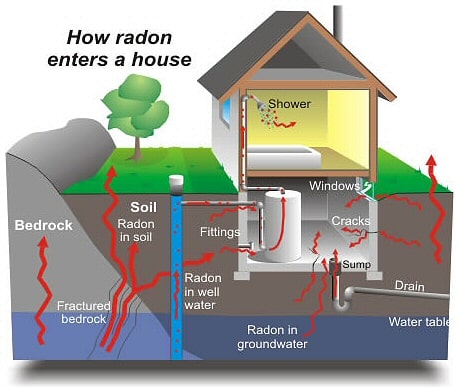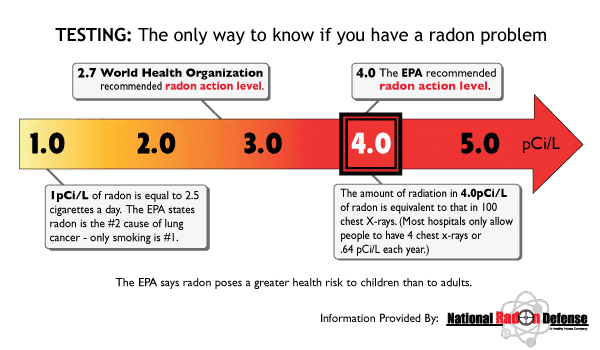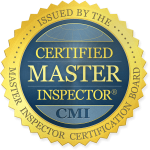Radon Testing
WHAT IS RADON?
Radon is a colorless, odorless, tasteless radioactive gas that's formed during the natural breakdown of uranium in soil, rock, and water. Radon exits the ground and can seep into your home through cracks and holes in the foundation. Radon gas can also contaminate well water.
Health officials have determined that radon gas is a carcinogen that can cause lung cancer. Studies show that radon is more of a risk to smokers, but nonsmokers have a slightly elevated chance of developing lung cancer when radon levels in the home are high. The only way to find out if your house contains radon gas is to perform radon tests.
EPA Radon Studies
The EPA offers a look at what they believe to be the risks of radon at different concentrations for 1,000 people who smoked and were consistently exposed to a certain level of radon during their lifetimes.
Radon Risks for Smokers
• With exposure to 10 pCi/L, about 71 would get cancer, equal to 100 times the risk of dying in a home fire.
• With exposure to 4 pCi/L, about 29 would get cancer, equal to 100 times the risk of dying in a plane crash.

Radon Risks for Non-Smokers:
• With exposure to 8 pCi/L, about 3 would get cancer, equal to 10 times the risk of dying in a plane crash.
• With exposure to 4 pCi/L, about 2 would get cancer, equal to the risk of drowning.
Facts About Radon Gas
• There are no average radon levels for a specific city, state, or region.
• Houses without basements are as much at risk of radon contamination as houses with basements.
• It doesn't matter if your neighbor's radon test was low or high, results for your home may be completely different.
Acceptable Radon Levels
The Environmental Protection Agency, EPA, recommends you install a system to reduce radon gas in your home if the level of gas is 4 picocuries of radon per liter (pCi/L) or higher.

If Radon Levels Are Too High
About 0.4 pCi/L of radon is found in the outside air and the average indoor radon level is about 1.3 pCi/L. The EPA recommends you use mitigation techniques to reduce indoor radon if levels in your home are above 4 pCi/L (or 0.02 working levels [WL] if your lab uses that reporting method.)
How to Reduce Radon Gas in Your Home
Radon Gas Mitigation Methods
Radon levels can usually be lowered using a process called mitigation, a term that means to moderate something or make it less severe. Some radon mitigation methods prevent radon from entering your home and others reduce radon levels after the gas is there.
The EPA recommends you use mitigation techniques to reduce indoor radon if levels in your home are above 4 pCi/L (or 0.02 working levels [WL] if your lab uses that reporting method).
Common Radon Mitigation Methods
Soil Suction
A mitigation system draws radon from beneath the house and vents it away from the house through pipes.
Sealing Cracks & Openings
Sealing alone doesn't usually lower radon levels, but it can limit the flow of radon into a home and reduce the loss of air that's been heated or cooled.
House Pressurization
This method uses a fan to create pressure differences that help keep radon from entering the house.
Heat Recovery Ventilator (HRV)
Installed to increase ventilation, HRV uses the heated or cooled air being exhausted to warm or cool the incoming air. This type of system is most effective when used to ventilate only the basement of a house. Heating and cooling costs will likely rise when an HRV system is in place.
Eliminating Radon in Water
Use this type of system if you've determined that your private water supply is your home's source of radon.
• Point-of-entry treatments use charcoal filters or aeration devices to remove radon from water before it enters your home.
• Point-of-use devices remove radon at the tap, but they do nothing to reduce radon in unfiltered taps, such as your tubs, showers, and laundry areas, so radon in the air may remain high.
Radon Mitigation for Existing Homes
Your radon mitigation contractor can offer complete details about different types of radon reduction systems and will be in a better position to recommend the "best" system for your house after determining how radon is entering your home. Costs vary, but most systems can be installed for $1,000-$3,000.
Radon Mitigation for New Homes
If you're building a new home, now is the time to install a radon reduction system. The cost is far less than fitting a system after the home is built, and having the system in place will help the home's resale value.
The EPA offers important advice to help you find a qualified radon service professional.
If you are buying a home, be sure to include a radon contingency to your offer to purchase, stating the maximum level of radon that is acceptable to you. If tested levels are above that figure, you should have the right to back out of the contract with no penalties. Many standard forms contain a radon contingency addendum that can be added to your offer to purchase.

Schedule Your Radon Test Today!
With Northern Colorado's Best Inspection Team.

